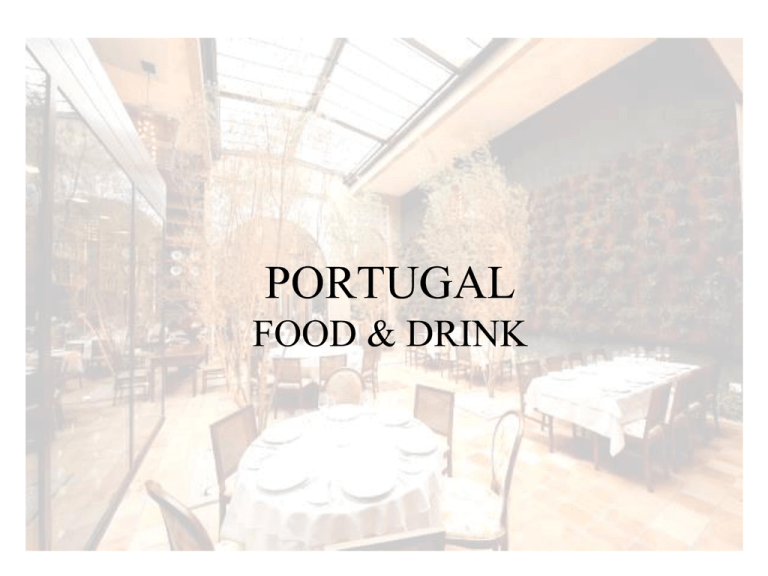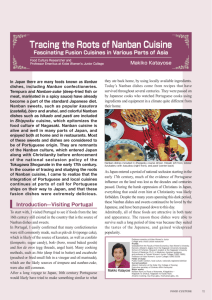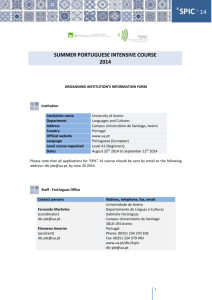PORTUGAL - Edublogs
advertisement

PORTUGAL FOOD & DRINK Portuguese cuisine influences Mediterranian cuisine Mediterranean cuisine is characterized by its flexibility, its range of ingredients and its many regional variations Portugal is a country where food is revered • Former colonial possessions The Portuguese were the first to bring to Europe, through their maritime adventures, spices like ginger, curry or pepper. Being the first Europeans to visit Japan and China, the Portuguese also introduced Europe to rice, tea, coffee. From the New World (the Americas) came the pineapple, potatoes and tomatoes. Meals • Breakfast Traditionally just coffee, milk and a bread roll with butter, jam, cheese or ham. Sweet pastries are also very popular. • Lunch Often lasting over an hour is served between noon and 3 o'clock and consists in three main couses • Dinner Is generally served late, around or after 8 o'clock, and has also three main courses (and it lasts longer than lunch ) Fish and seafood • Portuguese food varies from region to region, but fresh fish and shellfish are found on virtually every menu. The national dish is "bacalhau," dried, salted cod. The Portuguese have been obsessed with it since the early 16th century, when their fishing boats reached Newfoundland. The sailors salted and sun-dried their catch to make it last the long journey home, and today there are said to be 365 different ways of preparing it, one for each day of the year. • Grilled sardines and horse mackerel are also popular in the coastal towns, and a mixture of other types of fish is put into a stew called "Caldeirada." • The country is full of specialty seafood restaurants, many with artistic displays of lobsters, shrimp, oysters, and crabs. To try a mixture of these, have the rich seafood rice, "arroz de marisco." Meat • Another national dish is "cozido à portuguesa," a thick stew of vegetables with various kinds of meat. The favorite kind is pork, cooked and served in a variety of ways. Roast suckling pig ("leitão assado") is popular in the north of the country, as are pork sausages called "chouriço" or "linguiça." • Typical of Oporto, in the north, is tripe with haricot beans. It is not to everyone's taste, but has been Porto's most famous dish since Henry the Navigator sent a vessel to conquer Ceuta in Morocco and the people of Porto slaughtered all their livestock to provision the crew, keeping just the intestines for themselves. They have been known as "tripeiros" or "tripe eaters" ever since. • The Portuguese steak, bife, is a slice of fried beef or pork served in a wine-based sauce with fried potatoes, rice, or salad. To add a few more calories to this dish an egg, sunny side up, may be placed on top of the meat, in which case the dish acquires a new name, bife com um ovo a cavalo, steak with an egg on horseback. Iscas, fried liver, were a favourite request in old Lisbon taverns. Sometimes they were called iscas com elas, the elas referring to sautéed potatoes. Small beef or pork steaks in a roll (respectively pregos or bifanas) are popular snacks, often served at beer halls with a large mug of beer. Soups • Being a country with a wide rural population and ready availability of vegetables the soups are usually made from seasonal local grown produce. The soups often are a cheap replacement for a full meal and therefore they can be heavy in consistency and very tasty. • Caldo verde (literally green broth), made from a soup of kale-like cabbage thickened with potato and containing a slice of salpicão or chouriço sausage, originated from the northern province of Minho but is now considered a national dish. • Canja de galinha (chicken broth), is a filling, comforting and ubiquitous favourite. • Another soup-like typical dish is the açorda where vegetables or shellfish are added to thick rustic bread to create a 'dry' soup. Desserts • Many of the country's typical pastries were created in Middle Ages monasteries. • Other pastries were created by nuns in the 18th century, which they sold as a means of supplementing their incomes. Many of their creations, often with a high content of eggs and sugar in the composition, have related names like barriga de freira (nun's belly), papos de anjo (angel's chests), and toucinho do céu (bacon from heaven). • The Portuguese enjoy rich egg-based desserts. These are often seasoned with spices such as cinnamon and vanilla. • Cakes and pastries are very popular. Most towns have a local speciality, usually egg or cream based pastry. Originally from Lisbon, but popular nationwide, as well as among the diaspora, are pastéis de nata. These are small, extremely rich custard tarts. • Also popular is arroz doce (a typical and popular rice pudding, a must for Christmas time parties), is often decorated with elaborate stencilled patterns of cinnamon powder • in the Algarve region, many recipes include almonds and marzipan. Many traditional recipes also include candied squash, known as "doce de chila/gila" and candied egg threads called "fios de ovos," used as a filling or a decoration. Cheese There is a wide variety of Portuguese cheeses, especially made from goat's or sheep's milk, or both together. Usually these are very strongly flavoured and fragrant. Portuguese cuisine does not include cheese in its recipes, so it is usually eaten on its own before or after the main dishes. WINE Historically speaking it is difficult to be precise about the origin of vineyards in Portugal, and we have to goback to the era preceding the Bronze Age (1500 / 700A.C), so that we could find tracks of grape pips in the region of Leiria (centre of Portugal). Portugal became the first country of the world to create, in the Douro region, the first denomination of protected origin, imposing protectionist rules in designated areas, such as the type of cultivation, yield quality and control. These conditions that are still the base for criteria of all existing wine denominations in the world. Portugal ’s most famous contribution to the world of wine is undoubtedly Port and to a lesser extent, Madeira. These are both fortified wines, made by adding brandy spirit to fermenting musts • The Minho region produces light, refreshing white wines. The Douro, world’s firstde marcated wine region produces world-class red wines, with great power and complexity. The Bairrada region produces white and red wines with great ageing potential and the Dão region is stocked with the wealth of indigenous grape varieties that produces elegant white and red wines, while the Ribatejo is just emerging as a quality region. However, the Alentejo region is now well established as the premium wine region for producing wines with an excellent price/quality ratio, the reds being especially rich and silky LIQUEUR • Ginjinha or simply Ginja, is a liqueur made by infusing ginja berries, (sour cherry) in alcohol (aguardente is used) and adding sugar together with other ingredients. Ginjinha is served in a shot form with a piece of the fruit in the bottom of the cup (or not – com elas ou sem elas). It is a favourite liqueur of many Portuguese and a typical drink in Lisbon, Alcobaça and Óbidos (in this case it is served in a small edible chocolate cup). • In Portugal when someone is impressed by the taste of something, they say, " Sabe que nem ginjas " (It tastes even better than ginja). " Coffee: Portugal's Other National Drink Many assume that Portugal is famous only for Vinho do Porto (Port) and they are surprised when they discover that we also have a strong coffee culture that goes back many years. Portugal was responsible for introducing coffee production to Brazil. Portuguese drink espresso coffee – bica - that is how the portuguese like their coffee - no big American cups of brewed coffee, no lattes, and no tea. Portuguese can be found sitting and sipping the beverage while engaged in lively discussion, eating a pastry, or after a big meal.








![저기요[jeo-gi-yo] - WordPress.com](http://s2.studylib.net/store/data/005572742_1-676dcc06fe6d6aaa8f3ba5da35df9fe7-300x300.png)

